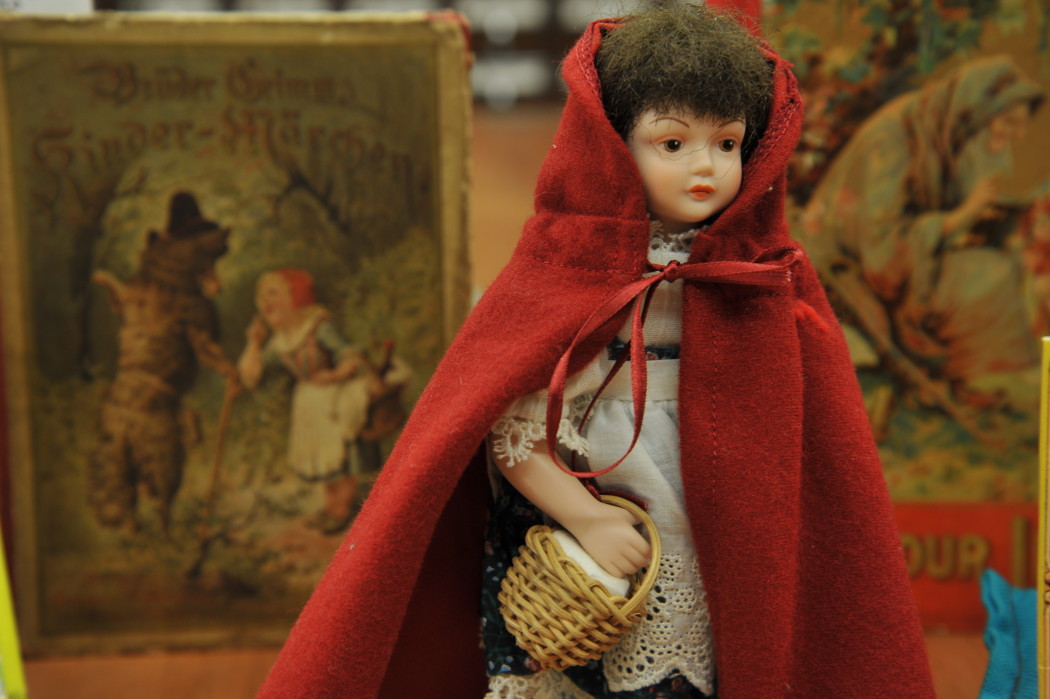Special Archives collection tells more than just a fairy tale
Over the river and through the woods, to grandmother’s house she goes. Her red cape hangs over her shoulders, a basket swings in her hand and a warning to stay on the path runs through her mind.
This is the premise of the popular children’s fairy tale, “Little Red Riding Hood.”
Originally penned in the 17th century by Charles Perrault, the fairy tale has been rewritten, changed and adapted into books, movies and collectible merchandise worldwide for centuries.
“A lot of people do collect Little Red Riding Hood memorabilia; it’s actually fairly common,” said Jennifer Duncan, the librarian and book curator in the Merrill-Cazier Library’s special collection archive. “Like, if you look at rare children’s book dealers, they’ll often have a whole section on their site for Little Red Riding Hood.”
One such collector was Brenda Branyan, a former faculty member of the department of instructional technology and learning science. Throughout her childhood, Branyan collected Red Riding Hood coloring books, fairy tales, dolls, needlework and more, Duncan said.
In 1997, Branyan donated a portion of her collection to USU and added to it over the years, Duncan said. Today the collection holds around 650 items.
The “Little Red Riding Hood” collection forms a snapshot in time for the late 20th century, Duncan said. Most collectors at the time focused more on older material and memorabilia from the 18th or 19th century.
“But what was unique about her collection is it’s much more contemporary,” she said, “so when we first brought the collection in, the date span was about 1970 to 1996.”
The collection’s narrow time period allows students and scholars to see how prevalent the folktale was in society at the time and how the pulse of the culture is represented through the materials of the collection, said Randy Williams, the folklore archives curator.
“You know that somebody was finding this at, like, Five-and-Dimes,” she said. “It was just so prevalent and there’s just so much more that she didn’t even collect. But why the 70s? Mass marketing, mass production, cheap labor.”
“Little Red Riding Hood” could tell more than just a fun story. Williams said it could be a study in popular culture, of mass marketing products, language, graphic design and more.
“It’s an academic collection. It’s not a marginal collection we just happen to have, it has a lot of meaning,” she said.
Nathalie De La Cruz Aquino, who is majoring in agricultural economics, found herself looking at the different ways Little Red Riding Hood was depicted depending on the book and the author’s cultural background.
“I really like the differences between the fairy tales and like how the person the author was, like where he was from, makes a difference,” she said. “Like, his cultural background is usually integrated into the story so you can see some of the differences, ‘Oh, this Little Red Riding Hood has blonde hair, whereas this one is brunette,’ and like stuff like that.”
How the fairy tale is depicted now versus how it was depicted at the time of the collection is interesting as well, Aquino said, because it shows how the story has changed over time to better fit the audience.
Fairy tales preserve the cultural heritage of a country or a particular moment in time, said Claudia Schwabe, an assistant professor of German.
“We have the tale that changes from century to century, different cultures, different countries, up to today.” Schwabe said, “When we look at the 21st century, for example, we see what writers have done with the fairy tale. All of a sudden, Little Red Riding Hood is no longer this innocent, naive young girl who strays from the path. But all of a sudden, she becomes much more emancipated.”
Adding new twists to the story helps modern television shows and films keep the audience entertained while sharing the tale’s moral messages, Schwabe said.
“In this one version, she actually is the one who kills the wolf,” Schwabe said. “So there’s this modern twist that she pulls out a shotgun from her knickers, you know, and she shoots the wolf and makes herself a nice little wolf fur coat.”
“Little Red Riding Hood” remains popular today because of its core themes, despite the changes made to it over time, Schwabe said. She said themes that focus on innocence and seduction, survival, monstrosity and compassion are still relevant in today’s society.
“Really, it’s a tale about sex and violence and rape, and that still is very, very important now-a-days as it was back then,” she said. “I think that’s why it speaks also still to the readership today.”
-miranda-lorenc@gmail.com
miranda_lorenc

